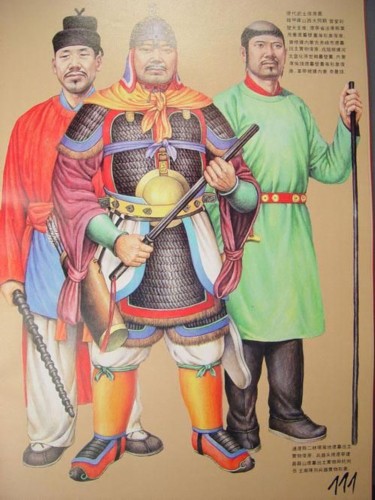Sung Dynasty Warriors (960 to 1279)
Contrary to the teleological narrative of traditional history, neither the profligacy of Hui-tsung’s court nor the policies of the Ts’ai Ching ministry were responsible for the fall of the Northern Sung. What doomed the dynasty was a concatenation of diplomatic and military crises, into which the emperor and his ministers blundered, and from which they proved incapable of extricating themselves. While the Sung armed forces were not outnumbered by their adversaries, they were ineptly commanded from the center, by an imperial court overconfident of certain victory. Unaware of their own strategic and tactical blind spots, Hui-tsung’s unaccountable councilors and generals could not marshal and coordinate the necessary fiscal and human might to defend the empire. More than any inherent disadvantages, a lack of will and leadership caused the collapse of the Northern Sung.
From the beginning of his personal rule, Hui-tsung pursued an aggressive expansionist military and diplomatic policy against the empire’s border adversaries, with ephemeral successes followed by total failures. In a series of ultimately fruitless campaigns against the Tangut Hsi Hsia, in 1103–6 and 1113–19, Hui-tsung pursued the conquest of territories that had already been gained and lost by Shen-tsung and Che-tsung. While they did succeed in destroying the Tanguts’ preeminent position on the north-western frontier, Sung commanders overextended themselves, snatching defeat from the jaws of victory.
If the imperial armed forces could not hope to defeat the Hsi Hsia after years of campaigns, they were clearly outmatched by the declining Khitan Liao empire, which occupied the Sixteen Prefectures coveted by Sung emperors since the dynasty’s inception. In 1119, tempted by the desire to reconquer this terra irredenta, Hui-tsung’s court entered into a diplomatic pact with the Jurchen, whose emerging and expansionist Chin empire threatened the Liao from the north. Planning to mount concerted attacks upon the Liao, the Sung and Chin leadership agreed to split the conquered territories between them. But the need to suppress the massive popular rebellions of Fang La in 1120 prevented the Sung court from fully mobilizing its forces against the Liao, and when they finally proceeded with their invasion plans a year later the imperial troops suffered severe setbacks. After the Jurchen conquered the Liao dynasty with little assistance from the Sung, Hui-tsung’s diplomats repeatedly enraged the Chin leadership with their excessive demands for more territory. Late in 1125, the Jurchen launched a punitive invasion of the Sung empire, breaking through border defenses and capturing strategic cities in the north. Although symbolic of renewed imperial resolve, Hui-tsung’s abdication in favor of his son Ch’intsung in the twelfth month of 1125 could not stave off disaster, for the new emperor and his revolving-door councilors vacillated between appeasement and resistance. Concluding peace at any price in 1126, the Sung extricated itself from its first war with the Chin only to have its diplomatic incompetence provoke a second, fatal conflict. In the second month of 1127, Jurchen forces invaded the North China Plain, sacked K’ai-feng, and took both Hui-tsung and Ch’in-tsung prisoner, effectively decapitating the dynasty. The dynasty fell because Hui-tsung’s councilors and commanders failed to acknowledge the military might of their adversaries or to accept accountability for their ill-conceived schemes, causing them to overconfidently stumble into war against an invincible foe.
